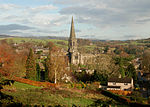Old Town Hall, Bakewell
BakewellCity and town halls in DerbyshireGovernment buildings completed in 1602Grade II listed buildings in DerbyshireUse British English from January 2024

The Old Town Hall, also known as The Buttermarket, is a former municipal building in King Street, Bakewell, a town in Derbyshire, England. The building, which is currently in retail use, is a Grade II listed building.
Excerpt from the Wikipedia article Old Town Hall, Bakewell (License: CC BY-SA 3.0, Authors, Images).Old Town Hall, Bakewell
South Church Street, Derbyshire Dales
Geographical coordinates (GPS) Address Nearby Places Show on map
Geographical coordinates (GPS)
| Latitude | Longitude |
|---|---|
| N 53.2126 ° | E -1.6769 ° |
Address
South Church Street
South Church Street
DE45 1EA Derbyshire Dales
England, United Kingdom
Open on Google Maps










